- Scientists found microplastics in people’s gallstones, and in the brains of mice
- Experts warn that microplastics won’t go away, only break down and get smaller
- READ MORE: Scientists found microplastics in clouds over mountains in China
Microplastics are everywhere: the air we breathe, the water we drink, and the food we eat.
Now it turns out these tiny particles can even infiltrate the brain and other organs, according to a pair of new studies.
In one of the studies, scientists who fed microplastics to otherwise healthy mice found that the substances wound up in the animals’ livers, kidneys, and brains, where they may cause untold damage. The animals were exposed for a relatively short time, four to eight weeks.
The other saw that microplastics are found in people’s gall bladders, where they seemed to contribute to gallstones, which can lead to pancreatitis and increased risk of pancreatic cancer.
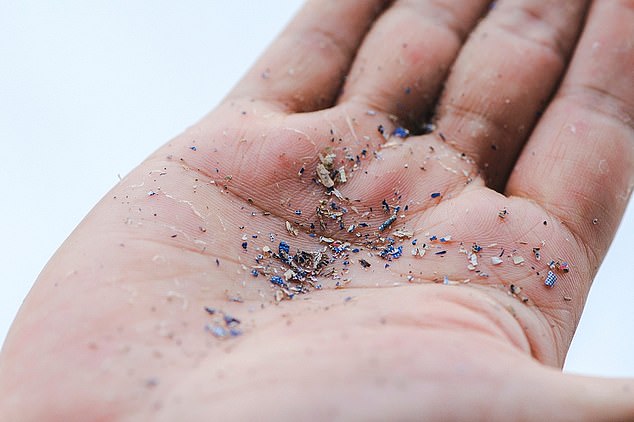
Microplastics are defined as plastic particles smaller than five millimeters, but in many cases the particles are smaller than 100 micrometers, meaning they can just barely be seen by the unaided eye.
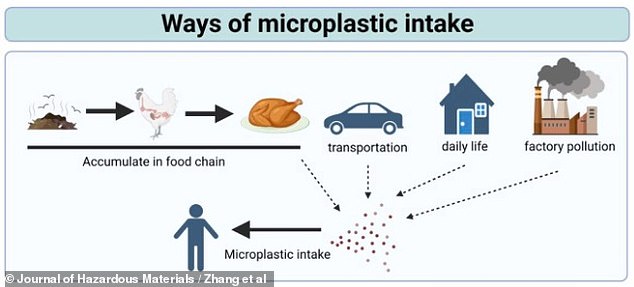
This diagram from a new study on microplastics accumulating in gallstones shows how microplastics end up in our bodies. They get into our food because the animals we eat, such as chickens, consume foods laden with microplastics.
READ MORE: Microplastics were found in 100 PERCENT of human placentas tested by scientists
Out of 62 human placenta samples they tested, every single one contained some trace of plastics. Experts said this means microplastics are probably being transmitted to babies in the womb.
The studies are significant because they show how quickly microplastics can make their way from food into multiple organs in the body.
The gallstones are significant because young people had more microplastics than older people, suggesting that exposure to microplastics is having a more serious effect on people who get exposed to them from an earlier age.
Scientists are still studying all the ways microplastics can affect our health, but they seem to increase inflammation, which can cause many ill effects downstream, including increased risks of cancers and even dementia.
‘These mice were exposed for four weeks,’ said Eliseo Castillo, an associate professor of gastroenterology and hepatology at the University of New Mexico, who led the study that found microplastics in the brain.
‘Now, think about how that equates to humans, if we’re exposed from birth to old age.’
And experts suspect we will never be rid of them.
‘Plastics don’t ever go away, they just break down to smaller and smaller sizes,’ said John Scott, a chemist at the Illinois Sustainability Technology Center, who was not involved in the new work.
Microplastics are so abundant, in fact, that Scott actually expects to see them in everything he examines.
‘They’re always out there,’ he said. ‘If I analyze something that doesn’t have microplastics in it, I think there’s something wrong.’
Around the same time as the latest microplastics studies came out, ambassadors and scientific advocacy groups met in Washington, DC, to discuss an upcoming set of negotiations to set international standards to reduce the harm of plastics: The Global Plastics Treaty.
But in a lot of ways, the harm is already done, some experts say.
Microplastics come from larger pieces of plastic waste breaking down into fragments.
They’ve been found on beaches, in Antarctica, and at the tops of mountains in China.
In other words, they are everywhere.
Since most plastics won’t biodegrade in the environment like food waste or paper will, the millions of tons of plastic out there in the environment will likely never disappear.
And the new studies showed what happens when they get into the bodies of people and animals.
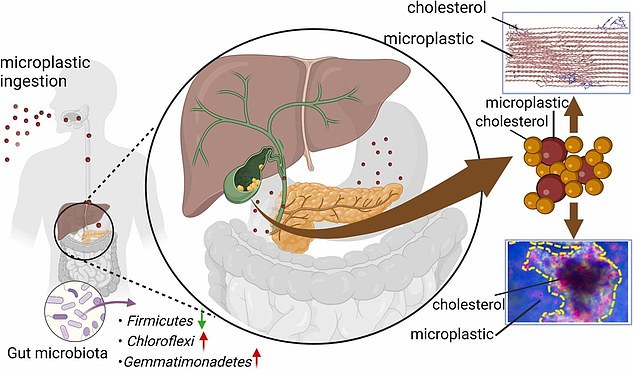
When people ingest microplastics, these tiny fragments make their way through the digestive system. They bind with cholesterol, and can end up forming gallstones.
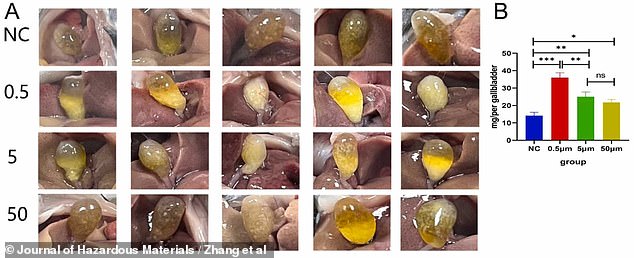
Mice that ate a high-cholesterol diet formed gallstones (top row), but mice who ate a high-cholesterol diet along with microplastics formed much more severe gallstones (bottom three rows). The mice that consumed microplastics 0.5 micrometers in size formed the most severe gallstones (second row from top).
In the first study, scientists found that mice who are fed microplastics end up with gallstones that contain microplastics.
Gallstones are small, crystallized masses of hardened digestive fluid that form in the gallbladder.
Doctors don’t know for sure what causes gallstones, but they suspect they occur when you have too much cholesterol in your bile, too much of the protein bilirubin, or if your gallbladder doesn’t empty correctly.
A team of scientists in China first sampled gallstones from 16 people (eight men and eight women) after they had them surgically removed.
‘The presence of microplastics in the gallstones of all the patients were confirmed,’ the team wrote.
Surprisingly, they found much higher levels of microplastics in the gallbladders of the patients who are under 50 years old, ‘indicating that younger patients may be more affected by microplastic pollution.’
Next they attempted to replicate this phenomenon in mice.
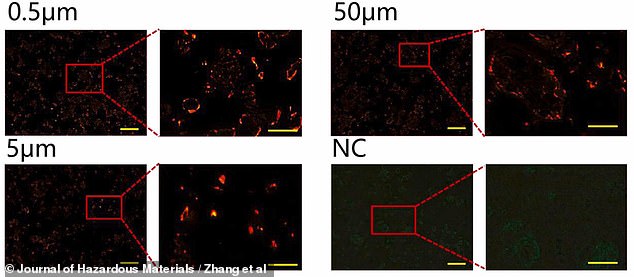
These images show the gallstones from mice who consumed 0.5-micrometer microplastics (top left), 5-micrometer microplastics (bottom left), 50-micrometer microplastics (top right), and no microplastics. The smaller the particles, the more they accumulated in the mice’s gallstones.
All the mice were fed a high-cholesterol diet, and some had their drinking water infused with microplastics ranging in size from 0.5 micrometers to 50 micrometers.
After eight weeks, they euthanized the mice and dissected their gallbladders.
All the mice developed gallstones, seemingly from the high-cholesterol diet.
But the organs of the mice who had been drinking microplastics were much more severe.
Those who drank smaller microplastics had significantly heavier gallstones than those who drank larger ones, suggesting that smaller microplastics have an easier time infiltrating organs.
Microplastics in general have an easy time accumulating in the presence of fats, because they tend to act as sponges that bond to things like fat.
There are negative effects beyond gallstones, too, they found.
This team published the study in the Journal of Hazardous Materials.
‘Moreover, an imbalance in the gut microbiota was observed in gallstone model mice after microplastic intake, characterized by a decrease in the abundance of beneficial bacteria,’ the scientists wrote.
In the other study, a team of scientists fed mice microplastics twice a week for four weeks.
All of the microplastics were 5 micrometers in size, but different groups of mice received different amounts.
Eight mice received none, eight received 2 milligrams a week, and eight received 4 milligrams a week.
The mice were then euthanized and dissected, and their body parts were examined.
Scientists found microplastics had made their way into the blood, brain, liver, and kidneys of all the mice that had been fed microplastics.
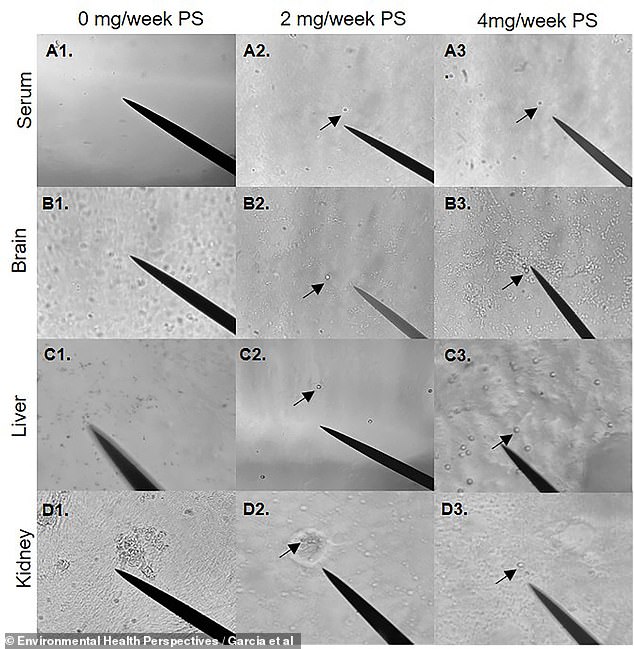
These tissue samples came from mice fed 0mg of polystyrene a week (left column), 2mg a week (middle column), or 4mg a week (right column). The mice fed polystyrene had evidence of the substance in their blood, brain, liver, and kidneys.

A second set of tissue samples came from mice fed 0mg of mixed plastics a week (left column), 2mg a week (middle column), or 4mg a week (right column). The mice fed the mixed plastics had evidence of the substance in their blood, brain, liver, and kidneys.
‘We could detect microplastics in certain tissues after the exposure,’ Castillo said. ‘That tells us it can cross the intestinal barrier and infiltrate into other tissues.’
The team published its findings in the journal Environmental Health Perspectives.
Castillo says he’s also concerned about the accumulation of the plastic particles in the human body.
‘These mice were exposed for four weeks,’ he says. ‘Now, think about how that equates to humans, if we’re exposed from birth to old age.’
They did not study the health consequences for the mice, but the health consequence of microplastics in people are getting more attention, lately.
Studies have shown they seem to contribute to inflammatory bowel disease and potentially Alzheimer’s disease.
Amid the growing concerns about microplastics in our bodies and in the environment, 175 UN member countries have agreed to come up with a plan this year to end plastic pollution – a global plastics treaty.
At a talk leading up to a new set of negotiations, officials explained that the goal is a ‘circular economy,’ in which substances we use can be reused, minimizing the waste we put out into the world that can end up back in our bodies.
‘Plastic does not belong in the circular economy,’ said Jamala Djinn, Ph.D., the science and policy advisor for Break Free From Plastic, at an April 8 event held in preparation for the upcoming fourth round of negotiations of the Global Plastics Treaty in Ottawa, Ontario (INC-4).
The circular economy doesn’t just describe recycling, though, as many chemicals from plastics reach the environment even when they are recycled.
‘We are not going to recycle or way out of this issue,’ Djinn said.
Read more
News Related-
Antoine Dupont still hurt by 'injustice' of World Cup loss to Springboks
-
China's New Aircraft Carrier Begins Catapult Testing
-
Aircraft Downed Inside Russia By Patriot System: Ukrainian Air Force
-
“Am I Prog’s Taylor Swift? That’s a debate that could run and run”: why Peter Hammill re-recorded his Enigma-era albums
-
Car With Pro-Russian Fighters Blown Up by Resistance: Exiled Mayor
-
Europe and African nations must find effective common ground in dealing with migration influx
-
Springbok lock opts not to renew contract with URC team
-
Pravin Gordhan’s deathly legacy: A threat to SA’s economic future
-
Antoine Dupont STILL hurt by ‘injustice’ of Rugby World Cup loss to Springboks
-
Rubber stamping NHI Bill will have damaging consequences for SA for generations
-
Inside horrific conditions Hamas hostages suffered including losing 15lbs in 50 days
-
After the Bell: SA’s NHI healthcare disaster starts right here
-
Gupta-linked development land for sale
-
Gary Neville begrudgingly claims brilliant Man Utd midfielder ‘looked like a Man City player’ in Everton mauling
